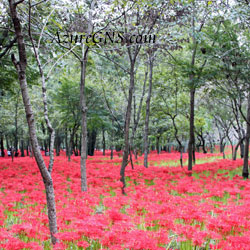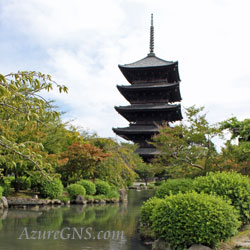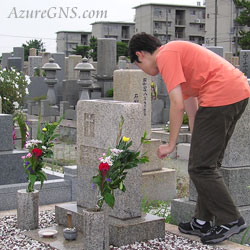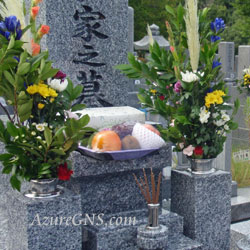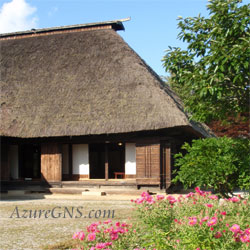国民の祝日
(9月22日頃)
National Holiday
Shubun-no-hi;
Autumn Equinox Day
(on and around September 22nd)
●春分の日 Shumbun-no-hi; Vernal Equinox Day
●秋分の日 Shubun-no-hi; Autumn Equinox Day
●夏至 the summer solstice
●冬至 the winter solstice
●彼岸 the equinoctial week
●赤道 the equator
●煩悩 worldly desires; earthly desires; worldly passions; earthly passions
●先祖;祖先 ancestor; (主に男性)forefather; (集合的に)ancestry
●子孫 descendant;(集合的に)posterity
●墓 grave; tomb
●墓地 graveyard;(教会に属さない共同墓地)cemetery;(教会付属)churchyard; (婉曲的に)memorial park
●墓参りをする (to) visit one’s grave
◆昼と夜の長さがほぼ同じ長さになる日が年2回あります。
There are two days in the year, when the length of daylight and night are almost equal.
◆春のその日を春分の日、秋のその日を秋分の日といいます。
One is in spring called Shumbun-no-hi (Vernal Equinox Day), and the other is in autumn which is called Shubun-no-hi (Autumn Equinox Day).
◆これらの日、太陽は赤道の上を横切り、太陽は真東から昇り、真西に沈みます。
On these days, the sun is positioned directly over the equator and rises in the east and sets in the west.
◆春分の日は3月22日頃、秋分の日は9月22日頃です。
Shumbun-no-hi is on or around March 22nd, and Shubun-no-hi is on or around September 22nd.
◆春分の日を境に夏至まで昼が徐々に長く、夜が徐々に短くなります。
From Shumbun-no-hi to the summer solstice, the days gradually become longer while the nights become shorter.
◆秋分の日を境に冬至まで昼が徐々に短く、夜が徐々に長くなります。
From Shubun-no-hi to the winter solstice, the days gradually become shorter while the nights become longer.
◆春分の日や秋分の日を挟んだそれぞれの1週間を彼岸と呼びます。
We call the seven days centering on Shumbun-no-hi or Shubun-no-hi as Higan.
◆極楽は西方にあり、この時期の夕日は人々を極楽へ導くと考えられています。
Paradise is thought to be in the west while sunset at this time is believed to lead people to Paradise.
◆それゆえに彼岸は日本の仏教でとても大切な意味があります。
Higan is, therefore, very significant in Japanese Buddhism.
◆また彼岸は季節の変わり目とも考えられ、「暑さ寒さも彼岸まで」とよく言われます。
Higan is also considered the change of season, and the Japanese often say, “Neither summer heat nor winter cold lasts beyond Higan.”
◆春分の日が過ぎると、寒い冬が終わって、次第に暖かくなってきます。
After Shumbun-no-hi, the cold winter days are over, and it gradually gets warmer.
◆秋分の日が過ぎると、暑い夏が終わって、次第に涼しくなってきます。
After Autumn Equinox Day, the hot summer comes to an end, and it gradually becomes cooler.
◆1948年(昭和23年)7月20日に春分の日と秋分の日は国民の祝日に制定されました。
On July 20th of 1948 (Showa 23rd yr), Shumbun-no-hi and Shubun-no-hi were designated as national holidays.
◆春分の日の趣旨は「自然をたたえ、生物をいつくしむ」ということです。
The purpose of Shumbun-no-hi is “to admire nature and to love all living things.”
◆秋分の日の趣旨は「祖先をうやまい、故人をしのぶ」ということです。
The purpose of Shubun-no-hi is “to worship ancestors and honor their memory.”
◆日付は前年の2月1日に国立天文台の官報で発表されます。
The dates are published in the official gazette of the National Astronomical Observatory, on February 1st of the previous year.
◆戦前は春分の日は春季皇霊祭、秋分の日は秋季皇霊祭と呼ばれました。
Before World War ll, Shumbun-no-hi was called Shunki-koreisai, and Shubun-no-hi was called Shuki-koreisai.
◆天皇、皇后両陛下がこれらの行事に出席して、皆で先祖を祀る行事が行われました。
The Emperor and the Empress attended these events, and everyone worshiped their ancestors.
◆多くの人が家族揃って先祖のお墓に行き、心を込めて掃除をします。
Many people go to their ancestors’ graves and wholeheartedly clean them.
◆線香、花、水、そして果物、お菓子、煙草、お酒など故人が好きだったものをお供えして、お参りをします。
They pray for the ancestors after offering incense, flower, water and whatever the deceased liked such as fruits, sweets, cigarettes and sake.
(より詳しい情報は「春分の日」と「お盆」をご覧下さい。)
(Please see “Vernal Equinox Day” and “The Buddhist Souls Festival” for further information.)
Copyright (C) Azure Global Network Services. All Rights Reserved.
